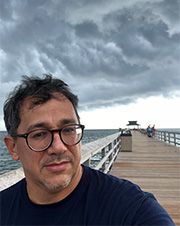Near-surface scattering in seismic data: from signal to noise and noise to signal
OR
SEG members, view the course for free!
Format: Virtual Webinar. 45 min. presentation followed by 15 min. Q&A
An optional post-lecture workshop will immediately follow each lecture for expanded Q&A and networking
Session 1, Tuesday, Aug. 16, 2022, 10 am to 11 am US Central Time
Session 2, Thurs, Oct. 6, 2022, 3 pm to 4 pm Rio de Janeiro Time
SEG Members Free Access Details
Two live sessions are completed. Please scroll down to watch the videos from the recordings below. SEG members, view the course for free!
Abstract
Processing of land and ocean-bottom seismic data share the task of attenuating coherent signal that propagates at the interphase of an acoustic and an elastic medium and that is often aliased contaminating early and late arrivals in seismic records. This noise originates from boundary conditions between two distinct property media such as a water column and shallow sediments with motion sensors located at the water bottom. Removal of such signal becomes problematic if the interface waves scatter due to shallow heterogeneities. The scattered waves have a distinctive moveout that appears at an offset from the shot location. The forward scattered wave, for the most part, constructively interferes with a transmitted forward propagating wave, while the backscattered wave moves away from the forward scattered wave. A challenging task for both land and marine ocean bottom data is to remove the interphase transmitted and the scattered waves. In land data, the dispersed wave is known as a Rayleigh wave if the source is a P- or SV-wave source. In ocean-bottom recordings, the transmitted wave is a Scholte wave produced from a P-wave source located in the water layer. The near-surface scattered wave frequently recognized in water-bottom data appears only in the motion sensor components and is often described as “shear-wave leakage” when seen in the vertical component.
In the literature, there have been two general analyses to the near-surface scattering problem in terms of its understanding and application, with little explicit overlap between the two. The more visited one is the noise attenuation problem, and there have been numerous approaches to this problem with varying degrees of success. The second view corresponds to using the noise as signal, but with fewer widespread applications. This lecture makes a review of the topic and describes the near-surface scattering problem for both land and ocean bottom data, with an emphasis on the second given the growing interest in this type of acquisition.

Your Instructor

Carlos Calderón-Macías joined ION Geophysical in 2006 advising seismic multicomponent, imaging, and model building. He is currently chief geophysicist in research and development. Carlos graduated with a PhD in geophysics from the University of Texas at Austin in 1997 and earned a bachelor’s degree in geophysical engineering from the National Autonomous University of Mexico in 1992. Upon graduating from UT Austin, Carlos joined Mobil Technology as a visiting scientist doing research in multiple elimination and imaging technology. He joined the Mexican Institute of Petroleum (2000) doing research in multicomponent seismic for hydrocarbon exploration. Within ION Geophysical, Carlos has helped develop imaging and model-building technology for 3D seismic marine exploration, advised imaging/model building projects in the GOM and offshore Brazil, and has taught educational courses and workshops. Carlos is currently an associate editor for Geophysical Prospecting and has been an SEG member for the past 25 years.
